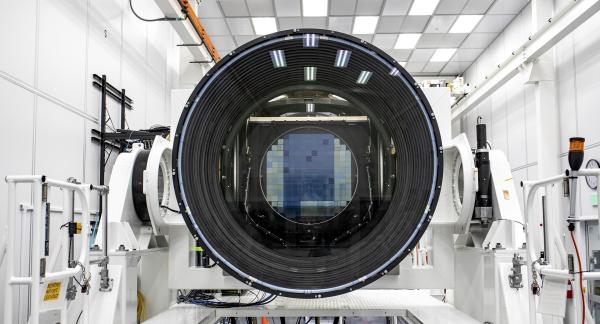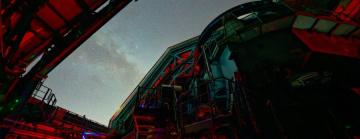NSF–DOE Rubin Observatory test camera sees the sky
The observatory's practice camera has captured its first on-sky data.
LSST Camera
Vera C. Rubin Observatory will search wide and deep into the cosmos for signs of dark matter and dark energy and yield new insights into our own galaxy and solar system. SLAC built Rubin's LSST Camera (above), the largest camera ever built for astrophysics. SLAC will also host Rubin's U.S. Data Facility and co-lead the observatory's operations along with NSF's NOIRLab. (Image Credit: Jacqueline Ramseyer Orrell/SLAC National Accelerator Laboratory)

NSF–DOE Vera C. Rubin Observatory passed its first end-to-end engineering test using a low-resolution testing camera known as the Commissioning Camera. The Commissioning Camera will later be replaced with the much higher resolution LSST Camera, the largest digital camera ever built, which Rubin Observatory will use to conduct the most comprehensive data-gathering mission in the history of astronomy – the 10-year Legacy Survey of Space and Time. Rubin is funded by the U.S. National Science Foundation and U.S. Department of Energy's Office of Science.
The mood in the observatory control room was electric as Rubin’s first on-sky data was captured by the test camera and transferred successfully from the observatory in Chile to the U.S. Data Facility at SLAC National Accelerator Laboratory in California. This moment was the culmination of decades of hard work by the Rubin team. Those present in Chile gathered at the base of the Simonyi Telescope to celebrate the major milestone.
This engineering achievement demonstrates that Rubin Observatory now has a complete and functioning telescope, with light from the stars traveling through the telescope optics, being captured by Rubin’s Commissioning Camera and appearing on the Rubin teams’ computer screens as a digital image. Rubin’s Commissioning Camera was designed to be physically the same size as the planned LSST Camera, but the detector itself is about 20 times smaller: just 144 megapixels compared to the 3200-megapixel science camera. The test camera will enable the Rubin team to verify key components of the system and resolve issues before installation of the actual camera that will be used for science.
The process of taking Rubin’s first data with the Commissioning Camera began well before sunset, with the team readying the telescope, dome and mirrors. They conducted twilight calibrations while the sky was still dimming, then pointed the telescope towards a bright star to confirm pointing and focus. At 10:04 p.m. local time in Chile, with the sky fully dark, the team prompted the Commissioning Camera to take a 60-second exposure.
Once the team heard the image was successfully received in California, cheers erupted from Rubin staff members in Chile, as well as everyone who had gathered at various sites and online to participate in this momentous event.
Having reached this milestone, the engineering team will now focus on precisely aligning and shaping the mirrors to achieve optimal image quality with the Commissioning Camera. They will then test the pipelines that process Rubin data and make the data available to scientists. At the same time, work will continue on preparing the LSST Camera for installation on the telescope, expected in January 2025. A commissioning period of approximately six months will follow, leading to Rubin’s first public release of astronomical images in mid-2025.
This important step brings us closer to the start of Rubin’s Legacy Survey of Space and Time, which will revolutionize our quest to explore the cosmos. Rubin will create the ultimate movie of the night sky using the largest camera ever built – repeatedly scanning the sky for a decade to create an ultra-wide ultra-high-definition time-lapse record. This unique movie will bring the night sky to life, yielding a treasure trove of discoveries: asteroids and comets, pulsating stars, and supernova explosions. With Rubin data we will all understand our Universe better, chronicle its evolution, delve into the mysteries of dark energy and dark matter and reveal answers to questions we have yet to imagine.
NSF–DOE Vera C. Rubin Observatory is a joint initiative of the U.S. National Science Foundation (NSF) and the U.S. Department of Energy’s Office of Science (DOE/SC). Its primary mission is to carry out the Legacy Survey of Space and Time, providing an unprecedented data set for scientific research supported by both agencies. Rubin is operated jointly by NSF NOIRLab and SLAC National Accelerator Laboratory. NSF NOIRLab is managed by the Association of Universities for Research in Astronomy (AURA), and SLAC is operated by Stanford University.
For more information, read the press release on the Rubin Observatory website.
About SLAC
SLAC National Accelerator Laboratory explores how the universe works at the biggest, smallest and fastest scales and invents powerful tools used by researchers around the globe. As world leaders in ultrafast science and bold explorers of the physics of the universe, we forge new ground in understanding our origins and building a healthier and more sustainable future. Our discovery and innovation help develop new materials and chemical processes and open unprecedented views of the cosmos and life’s most delicate machinery. Building on more than 60 years of visionary research, we help shape the future by advancing areas such as quantum technology, scientific computing and the development of next-generation accelerators.
SLAC is operated by Stanford University for the U.S. Department of Energy’s Office of Science. The Office of Science is the single largest supporter of basic research in the physical sciences in the United States and is working to address some of the most pressing challenges of our time.






